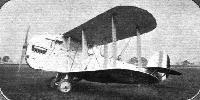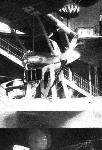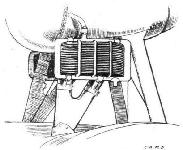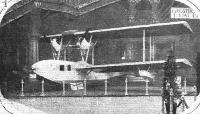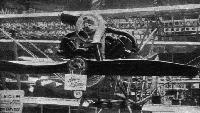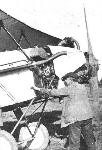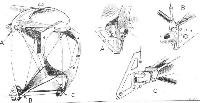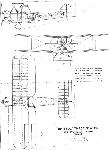Фотографии
-
A D.H.9b, with Rolls-Royce "Eagle" engine, remodelled by the Aircraft Disposal Company.
Самолёты на фотографии: De Havilland D.H.9A - Великобритания - 1918
-
Регистрационный номер: N9451 The Fairey Series IIID, converted to a land machine by the substitution of long-travel oleo undercarriage for floats. A 450 h.p. Napier "Lion" is fitted to this machine. Aeroplane has variable camber wings.
Самолёты на фотографии: Fairey Fairey III - Великобритания - 1917
-
Savoia 53
Самолёты на фотографии: SIAI S.16 / S.53 - Италия - 1919
-
Two Vickers "Viking" Amphibians, with Rolls-Royce "Eagle" engines.
Самолёты на фотографии: Vickers Viking / Type 54 - Великобритания - 1919
-
The Vickers "Vimy-Commercial," with two Napier "Lion" engines. The "Vernon" troop carrier is very similar in general appearance.
Самолёты на фотографии: Vickers Vimy Commercial - Великобритания - 1919
-
The Avro 504K is fitted with a 175 h.p. Siddeley "Lynx" Engine.
Самолёты на фотографии: Avro Avro 504 - Великобритания - 1913
-
Регистрационный номер: N138 THE PARNALL "PUFFIN" DECK-LANDING AMPHIBIAN: Side view. As this machine belongs to the Air Ministry no technical details may be given beyond those which can be gathered from the photographs. The machine, which has a 450 h.p. Napier "Lion" engine, is unusual in having a single main float.
Самолёты на фотографии: Parnall Puffin - Великобритания - 1920
-
Nieuport-Astra Type 29C1 1923
Самолёты на фотографии: Nieuport Nieuport-29 - Франция - 1918
-
Nieuport-Astra Type 29C1
Самолёты на фотографии: Nieuport Nieuport-29 - Франция - 1918
-
Caudron
Самолёты на фотографии: Caudron G.3 - Франция - 1913
-
Регистрационный номер: J6852 [2] FIRST FLIGHT OF THE 1,000 H.P. NAPIER-AVRO BOMBER: On the left, Bert Hinkler and crew take off at Hamble. December 15, on the Avro Bomber, fitted with a Napier 1,000 h.p. "Cub." Below, just before the flight. On the right, a close-up view of the "Cub" safely installed in its cage.
Самолёты на фотографии: Avro Aldershot / Type 549 - Великобритания - 1922
-
Регистрационный номер: J6852 [2] FIRST FLIGHT OF THE 1,000 H.P. NAPIER-AVRO BOMBER: Three views of the Avro Bomber, with Napier "Cub," a modification of the Avro " Aldershot."
Самолёты на фотографии: Avro Aldershot / Type 549 - Великобритания - 1922
-
The Avro-Viper, Wolseley-Viper engine.
Самолёты на фотографии: Avro Type 552 - Великобритания - 1921
-
Регистрационный номер: N153 The Avro "Bison" is a Fleet Gunnery Spotting Aeroplane fitted with Napier "Lion" engine.
Самолёты на фотографии: Avro Bison / Type 555 - Великобритания - 1921
-
S.I.M.B. Bernard Type C
Самолёты на фотографии: Bernard Bernard 10 / 12 - Франция - 1922
-
Регистрационный номер: N150 First prototype Blackburn Blackburn.
Самолёты на фотографии: Blackburn Blackburn / R.1 - Великобритания - 1922
-
Регистрационный номер: N120 The Short "Cromarty" is fitted with two Rolls-Royce "Condor" engines.
Самолёты на фотографии: Short N.3 Cromarty - Великобритания - 1921
-
The neat engine mounting and cowling of the C.A.M.S. flying boat.
Самолёты на фотографии: CAMS CAMS 30 / CAMS 31 / CAMS 32 - Франция - 1922
-
C.A.M.S. side-by-side flying boat for school work.
Самолёты на фотографии: CAMS CAMS 30 / CAMS 31 / CAMS 32 - Франция - 1922
-
Sketch showing the small Botali radiators on the C.A.M.S. flying boat.
Самолёты на фотографии: CAMS CAMS 30 / CAMS 31 / CAMS 32 - Франция - 1922
-
C.A.M.S. 30.E
Самолёты на фотографии: CAMS CAMS 30 / CAMS 31 / CAMS 32 - Франция - 1922
-
Caudron Type C.68
Самолёты на фотографии: Caudron C.27 / C.59 / C.60 - Франция - 1921
-
Caudron Type C.27
Самолёты на фотографии: Caudron C.27 / C.59 / C.60 - Франция - 1921
-
Caudron Type C.59
Самолёты на фотографии: Caudron C.27 / C.59 / C.60 - Франция - 1921
-
Caudron Type C.67
Самолёты на фотографии: Caudron C.27 / C.59 / C.60 - Франция - 1921
-
Регистрационный номер: N135 The Fairey Amphibian "Pintail," Mark III, 450 h.p. Napier "Lion" Engine.
Самолёты на фотографии: Fairey Pintail / Fawn - Великобритания - 1920
-
Morane-Saulnier
Самолёты на фотографии: Morane-Saulnier AR (MS-35) / AS (MS-36) - Франция - 1915
-
Farman
Самолёты на фотографии: Farman B.2 - Франция - 1924
-
Farman
Самолёты на фотографии: Farman F.130 - Франция - 1922
-
FBA Type 16HE2
Самолёты на фотографии: FBA Type 16 / 17 - Франция - 1923
-
The Gloucestershire Aircraft Co.'s "Mars VI", fitted with Siddeley "Jaguar" engine, a machine which has fine climbing and speed performances.
Самолёты на фотографии: Gloster Mars (Bamel) / Nighthawk / Sparrowhawk - Великобритания - 1921
-
Hanriot Type HD.14
Самолёты на фотографии: Hanriot HD.14 / HD.17 / HD.41 - Франция - 1920
-
Koolhoven Type FK.31
Самолёты на фотографии: Koolhoven FK-31 - Нидерланды - 1922
-
P.Levasseur
Самолёты на фотографии: Levasseur PL.2 - Франция - 1922
-
THE PARIS SALON: Loire and Olivier flying boat, which has two engines.
Самолёты на фотографии: Liore et Olivier LeO H.13 - Франция - 1922
-
Liore et Olivier
Самолёты на фотографии: Liore et Olivier LeO H.13 - Франция - 1922
-
The Borel S.C.I.M. all-metal biplane.
Самолёты на фотографии: Borel-Boccaccio Type 3000 - Франция - 1919
-
The Rateau supercharger on Borel all-metal biplane.
Самолёты на фотографии: Borel-Boccaccio Type 3000 - Франция - 1919
-
SOME CONSTRUCTIONAL DETAILS ON THE BOREL BIPLANE: 1. Wing tip and details of all-Duralumin construction; the spars are Duralumin tubes of rectangular section, while the ribs built up of channel sections. 2. Stirrup attachments of wing-bracing wires, and interplane strut socket. 3. A typical fuselage fitting; the Duralumin tube longerons are stepped down in diameter, a bush being inserted in the parallel socket for the smaller tube.
Самолёты на фотографии: Borel-Boccaccio Type 3000 - Франция - 1919
-
H.Potez Type VIII
Самолёты на фотографии: Potez Potez VIII - Франция - 1919
-
PURCHASED BY THE AIR MINISTRY: The Short "Silver Streak" all-metal biplane, which was exhibited at the last Olympia Aero Show, was delivered to one of our flying stations recently, as announced last week.
Самолёты на фотографии: Short Silver Streak - Великобритания - 1920
-
The single-float Breguet seaplane.
Самолёты на фотографии: Breguet Br.18 Berline / Br.14T - Франция - 1919
-
Breguet Type XIV
Самолёты на фотографии: Breguet Br.18 Berline / Br.14T - Франция - 1919
-
Регистрационный номер: G-EARY The Beardmore W.B.2 Commercial Biplane, with 160 h.p. Beardmore engine.
Самолёты на фотографии: Beardmore W.B.II - Великобритания - 1917
-
Fuselage of single-engined Breguet "Leviathan."
Самолёты на фотографии: Breguet Br.20 / Br.22 Leviathan - Франция - 1922
-
Two views of the twin-engined Breguet "Leviathan."
Самолёты на фотографии: Breguet Br.20 / Br.22 Leviathan - Франция - 1922
-
Sketch showing one side of the undercarriage of the twin-engined Breguet "Leviathan."
Самолёты на фотографии: Breguet Br.20 / Br.22 Leviathan - Франция - 1922
-
FUSELAGE FITTING AND BUILT-IN FORMER OF BREGUET "LEVIATHAN": On the right the peculiar wing-bracing wire fitting, with a stout central cable and two smaller cables front and rear.
Самолёты на фотографии: Breguet Br.20 / Br.22 Leviathan - Франция - 1922
-
L.Breguet Leviathan Type XXII
Самолёты на фотографии: Breguet Br.20 / Br.22 Leviathan - Франция - 1922
-
The Avro 80 h.p. Le Rhone Seaplane Two-seater.
Самолёты на фотографии: Avro Antarctic Baby / Type 554 - Великобритания - 1921
-
SECM Type XXIII
Самолёты на фотографии: SECM (Amiot) SECM 22 / 23 - Франция - 1922
-
Caudron
Самолёты на фотографии: Caudron C.61 / C.81 / C.183 - Франция - 1921
-
H.Potez Type XVIII
Самолёты на фотографии: Potez Potez X / XVIII / XXII - Франция - 1921
-
Latecoere Type Lat.6
Самолёты на фотографии: Latecoere Late 6 - Франция - 1924
-
Side view of the Handasyde Cantilever Monoplane with "Eagle IX" engines.
Самолёты на фотографии: Handasyde H.2 - Великобритания - 1922
-
Handley-Page "Hanley"
Самолёты на фотографии: Handley Page Hanley/H.P.19 / Hendon/H.P.25 - Великобритания - 1922
-
THE "BRISTOL" THREE-SEATER: Front view. |The man standing in front gives a good idea of the size of the machine.
Самолёты на фотографии: Bristol Taxiplane / Primary Trainer - Великобритания - 1923
-
THE "BRISTOL" THREE-SEATER: View showing how engine mounting is swung out to give access to back of engine.
Самолёты на фотографии: Bristol Taxiplane / Primary Trainer - Великобритания - 1923
-
THE "BRISTOL" THREE-SEATER: Three-quarter front view.
Самолёты на фотографии: Bristol Taxiplane / Primary Trainer - Великобритания - 1923
-
Регистрационный номер: G-EBEW THE "BRISTOL" THREE-SEATER: Three-quarter rear view.
Самолёты на фотографии: Bristol Taxiplane / Primary Trainer - Великобритания - 1923
-
THE "BRISTOL" THREE-SEATER: On the left, a diagrammatic representation of the aileron controls, in which use is made of cranks in place of pulleys. On the right, a diagram of the tail-trimming gear. The tail plane is hinged on its leading edge, and the trailing edge is moved up and down by horizontal "T" cranks and short struts.
Самолёты на фотографии: Bristol Taxiplane / Primary Trainer - Великобритания - 1923
-
THE "BRISTOL" THREE-SEATER: Details of the tail skid and its mounting. On the right may be seen one of the horizontal "T" cranks of the tail-trimming gear. Inset shows the renewable shoe of the tail skid.
Самолёты на фотографии: Bristol Taxiplane / Primary Trainer - Великобритания - 1923
-
THE "BRISTOL" THREE-SEATER: Some constructional details. 1, Spar fitting on top plane. The eye bolt engages with a forked end on the centre-section spar. 2, The bracket and bearings, on the front spar, for the cranks which are used instead of pulleys. 3, Details of aileron construction and fittings. Inset: Aileron hinge. 4, A typical fuselage fitting.
Самолёты на фотографии: Bristol Taxiplane / Primary Trainer - Великобритания - 1923
-
THE "BRISTOL" THREE-SEATER: The handle of the door giving access to the passengers' cockpit is so designed as to make, when locked, the door a load-resisting part of the fuselage structure,
Самолёты на фотографии: Bristol Taxiplane / Primary Trainer - Великобритания - 1923
-
THE "BRISTOL" THREE-SEATER: Details of the swivel mounting of the 100 h.p. "Bristol" Lucifer engine.
Самолёты на фотографии: Bristol Taxiplane / Primary Trainer - Великобритания - 1923
-
"Bristol" Three-seater 100 hp "Bristol" Lucifer Engine
Самолёты на фотографии: Bristol Taxiplane / Primary Trainer - Великобритания - 1923
-
THE FOKKER AMPHIBIAN: Front view. Note how machine floats on an even keel.
Самолёты на фотографии: Fokker B.I / B.III - Нидерланды - 1922
-
A NEW FOKKER AMPHIBIAN: This machine, which has been built for the Dutch Navy, has just undergone its first test flights. The boat hull is built entirely of Duralumin. The engine is a Napier "Lion."
Самолёты на фотографии: Fokker B.I / B.III - Нидерланды - 1922
-
THE FOKKER AMPHIBIAN: View showing amphibian gear and mounting of Napier "Lion" engine.
Самолёты на фотографии: Fokker B.I / B.III - Нидерланды - 1922
-
THE FOKKER AMPHIBIAN: Three-quarter rear view of machine on land.
Самолёты на фотографии: Fokker B.I / B.III - Нидерланды - 1922
-
Morane Saulnier
Самолёты на фотографии: Morane-Saulnier AV - Франция - 1922
-
Schneider
Самолёты на фотографии: Schneider Henri-Paul S.3 - Франция - 1922
-
THE PARIS SALON: Bellanger twin-engined flying boat, which has folding wings of crescent-shaped plan for. Note front gunner's cockpit.
Самолёты на фотографии: Bellanger-Denhaut BD-22 - Франция - 1923
-
THE BELLANGER FLYING BOAT: A front view of the port engine.
Самолёты на фотографии: Bellanger-Denhaut BD-22 - Франция - 1923
-
Sketch showing unusual engine cowling on Bellanger flying boat.
Самолёты на фотографии: Bellanger-Denhaut BD-22 - Франция - 1923
-
Bellanger Freres
Самолёты на фотографии: Bellanger-Denhaut BD-22 - Франция - 1923
-
De Monge-Buscaylet
Самолёты на фотографии: De Monge Type 5.2 - Франция - 1922
-
Nieuport-Astra Type 37C1
Самолёты на фотографии: Nieuport-Delage Ni-D-37 - Франция - 1923
-
Farman
Самолёты на фотографии: Farman F.200 - Франция - 1923
-
H.Potez Type XI CAP2
Самолёты на фотографии: Potez Potez XI - Франция - 1922
-
Liore et Olivier
Самолёты на фотографии: Liore et Olivier LeO H.10 - Франция - 1923
-
SECM BN2 Type X
Самолёты на фотографии: SECM (Amiot) SECM 10 / 12 BN2 - Франция - 1921
Статьи
- Flight















